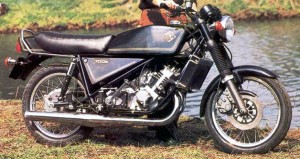| 1975–1979 Silk 700S |
|---|
| Performance |      |
|---|
| The Silk was basically a 1930s Scott Flying Squirrel motor mated to a '60s Velocette gearbox. The combination had some distinct oddities and anachronisms: deflector-type pistons, thermo-syphon (passive) water cooling, and lubrication via both premix and oil injection. Surprisingly, it all worked quite well, vibrating less than you'd expect, while generating a stately 45 horsepower with locomotive-grade torque and a mile-wide powerband. Clutches need constant attention to work properly. |
|
| Handling |      |
|---|
| The upside of the quirky motor is that it was small and light enough to fit into a modified Spondon 125 racebike frame, and the whole package ended up weighing just over 300 lbs. Suspension parts and tires were conventional for the time, but were quality items not cheaply sourced. Cornering limits were not high, but steering and handling were predictable. |
|
| Looks |      |
|---|
| I like its surreal but surprisingly agreeable mix of styling elements from several different decades, although overall it doesn't quite suit the most expensive production motorcycle in the world (it was at the time, costing the equivalent of $13–17K in today's dollars). |
|
| Reliability |      |
|---|
| It is a stout and simple machine, but with fewer than 150 ever made, parts are unobtainable. Owners should know a very good machinist very well. |
|
| Practicality |      |
|---|
| Certain temperamental quirks are present in all low-production bikes (and the Silk is more idiosyncratic than most), but the 700S was intended to be a workhorse, not a show pony. Despite their rarity, some owners tour great distances on their Silks and use them regularly as urban commuters. |
|
| Desirability |      |
|---|
| The fact that the old Scott two-stroke twin could still be made to work so well in a modern motorcycle half a century after it was first designed is amazing. |


